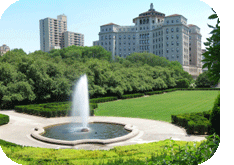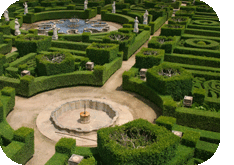
This mailer has been provided as an avenue of dispersing information related to landscape architecture in hopes of fostering greater understanding and collaboration between professions. Topics address issues that affect the built environment within which we live.
A sampling of how religion has formed our outdoor modern built environment.
"The physical world, as shaped by thought and action, mirrors the human mind as a theatre of myth, ritual, allegory, and reason", Elizabeth Rogers
 Many of us, at some point, have had a thought provoking question cross our mind such as,"who ever thought of using mold to cure disease?". As a landscape architect I often ponder similar questions related to my observations of the outdoor environment. "What is the appeal for manicured topiary and shrubs?", "Why is water in the landscape so desirable?", "Why are statues and public art in open spaces so valued?". The truth is that our modern landscapes have evolved over time into their current state. We have adopted the look and appearances from past landscapes and gardens, but have often left much of the original meaning and intent behind. Landscapes and gardens throughout history have been reflections of a culture's attitude toward nature, Deity, and humanity. Throughout history, from pre-historic civilizations to ancient Egyptians and the early settlers of America, religious expression, and the attempt to bring one closer to unseen spiritual forces, has been one of the main reasons for the creation of gardens and landscapes. The following article will introduce you to a few of the many spiritual origins and original intent of common landscape features in our modern built environment:
Many of us, at some point, have had a thought provoking question cross our mind such as,"who ever thought of using mold to cure disease?". As a landscape architect I often ponder similar questions related to my observations of the outdoor environment. "What is the appeal for manicured topiary and shrubs?", "Why is water in the landscape so desirable?", "Why are statues and public art in open spaces so valued?". The truth is that our modern landscapes have evolved over time into their current state. We have adopted the look and appearances from past landscapes and gardens, but have often left much of the original meaning and intent behind. Landscapes and gardens throughout history have been reflections of a culture's attitude toward nature, Deity, and humanity. Throughout history, from pre-historic civilizations to ancient Egyptians and the early settlers of America, religious expression, and the attempt to bring one closer to unseen spiritual forces, has been one of the main reasons for the creation of gardens and landscapes. The following article will introduce you to a few of the many spiritual origins and original intent of common landscape features in our modern built environment:
Formal Gardens - It is important to note that the seemingly innate need to maintain formal landscapes has been cultivated over a very long time. In many cultures, particularly those based in Islamic and Judeo-Christian beliefs, the concept of a paradisiacal garden is most prevalent. This concept has been imagined over time as a lush, tamed, structured, orderly and enclosed space, separated from nature. This imagery, and the intentional symbolism of obedience to the laws of Deity that come with it, has strongly influenced the formal nature of many of our landscapes.
Four Paths / Rivers - Many modern landscapes are derived (knowingly or not) from a geometric pattern formed by a central fountain from which four paths or four water bodies extend. This form originates through metaphoric symbolism of Islamic and Judeo-Christian representations of the paradisiacal rivers mentioned in the Quran and the Bible. This geometric form, with Deity represented in the center of the garden, also served as a reminder of where Deity actually resided within the landscape.1
Water - The use of water as a spiritual medium in landscape design is nearly universal across many cultures and remains a very symbolic element of many modern landscapes. It was often used to initiate contemplation, and to create an image consistent with a paradisiacal garden of tranquility, joy and beauty. Its reflective characteristics, when designed carefully, have been used to encourage the eyes to look up into the heavens, or into a virtual eternity. Water has also historically represented purity,cleanliness and rebirth.
 Hedges & Topiary - Inspiration for the beautiful hedges and immaculate topiary found in Renaissance and Victorian gardens is traced back to the forms and shapes found in Islamic garden carpets known as chahar bagh. Hedges were manicured and maintained often to keep the clean, neat appearance of static textile designs. The carpets (after which the hedges and gardens were designed) were literal representations of the quartered paradisiacal gardens noted above. These carpets showed in great detail the four watercourses, the central fountain and a variety of plants, each of which had a symbolic meaning for its placement. 1
Hedges & Topiary - Inspiration for the beautiful hedges and immaculate topiary found in Renaissance and Victorian gardens is traced back to the forms and shapes found in Islamic garden carpets known as chahar bagh. Hedges were manicured and maintained often to keep the clean, neat appearance of static textile designs. The carpets (after which the hedges and gardens were designed) were literal representations of the quartered paradisiacal gardens noted above. These carpets showed in great detail the four watercourses, the central fountain and a variety of plants, each of which had a symbolic meaning for its placement. 1
Processional Axis - One of the most visible impacts that religious based design has had on modern landscapes can be seen in tree lined promenades and strong axial designs of many modern urban cities such as Washington D.C. The axial forms of large gardens like Versailles and other urban cities have their roots in ancient processional axis or ceremonial ways. These linear roads were designed to accommodate the approach and movement of religious rituals and assemblies. They were also designed to honor Deity, manifesting power and prosperity.
These examples are only a few of the many that help explain how our modern landscapes have become what they are, hopefully this article will now have you looking at the outdoor built environment a little differently than you have in the past.
Prior Issues of Interest
- Universal / Inclusive Design - Part 1- Playgrounds
- Universal / Inclusive Design - Part 2 - Walks and Trails
- Playground Safety: What's the Big Deal?
- Artificial Turf: A Pros & Cons Review
-The Vestibular and Proprioceptive Sensory Systems
Click the video below to visit our YouTube channel and see the presentation "Re-Introducing Nature to Recreation" by O'Dell's landscape architect at the CPRS Bay Area Institute held in Menlo Park
References:
1-Rogers, Elizabeth Barlow. Landscape Design: A Cultural and Architectural History. Harry N. Abrams, Inc. New York. 2001
Author: Chad Kennedy, Landscape Architect
This informational article provided by O'Dell Engineering - Modesto | Palo Alto CA
